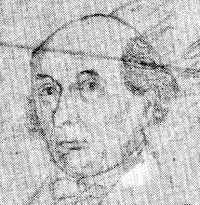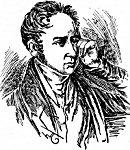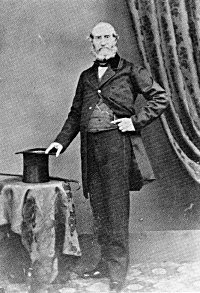
In 1775, Dr. Lake Taswell, a surgeon and apothecary living on High Street published, anonymously, his History of Portsmouth entitled A Portsmouth Guide. Though little more than a tourist booklet of 52 pages with some transport timetables it represented the first attempt to portray the rich heritage that was Portsmouth. Taswell made some revisions for a second edition, A New Portsmouth Guide in 1790 but it remained primarily aimed at the visitor, indeed the preface indicates that a principle motive for publishing the book was to correct the "erroneous accounts" that were misleading the visitor. Here is Taswell on Portsmouth's fortifications:-
"The fortifications were began by Edward IV augmented by the Kings Henry VII and VIII and Queen Elizabeth was at so great an expence in improving the works, that nothing was thought wanting in those days to compleat them; however Charles II added very much to their strength, extent and magnificence; and every year since, the succeeding kings have been making additions to the strength and beauty of the garrison: there is an annual allowance from government for keeping it in proper repair."

In 1797, Taswell's daughter Mary married Herbert Allen, a hatter of High Street and they set up house in Albert Road, Southsea on the spot later occupied by Nazareth House. Taswell was not pleased with the match, viewing Allen as a mere tradesman, so he banished his daughter from his house. Mary gave birth to a son in 1799 who was given his grandfather's first name. Lake Allen proved to be a sickly child who, often being in need of medical attantion, gradually moved in to live with his grandfather. We know little of Lake Allen's education but we do know that Lake Taswell imbued in his grandson a love of study, most notably in the classics.
As early as the age of 16 years Allen was writing articles on the history of Portsmouth and a mere two years later, in 1817, he published his History of Portsmouth. Although drawing heavily on his grandfather's work, Allen greatly extended the scope of the narration such that his book contained 252 pages, plus several appendices, the whole work littered with footnotes and references. Unusual for one so young he recognised the importance of working from original sources, quoting at length from the charters presented to the people of Portsmouth over the centuries. His style was distinctive as can be seen from this extract recounting the excellence of Portsmouth's harbour:-
"...that there be no bars or other obstructions to embarrass the entrance, and which may render the access difficult or dangerous:- Portsmouth Harbour is not broader than the Thames at Westminster, and as the water flows seven and ebbs but five hours, the flux is greater out than in; so that the bottom is always scowering, and the water running out at an angle, throws the bar to the S.W. which is called the spit, and leaves a deep channel close under the shore to South-sea Castle."
The book was greeted warmly by the people of Portsmouth who agreed that it was, despite some inaccuracies, a remarkable achievement. Allen acquired a level of celebrity that quickly attracted the attention of another young man with a taste for knowledge. Frederick Madden was two years younger than Lake Allen, whom he described as "having a head too large in proportion to his body", and came from a wealthy family living in one of the most prestigious houses in Portsmouth - 31 St Thomas's Street. William John Madden, Frederick's father, had served in the Royal Marines as Captain and Paymaster and later founded his own agency acting as financial advisor to his former comrades. The family comprised of up to 12 children of which Frederick was the seventh son.
At the time that Madden first met Allen he was still in formal education, attending a school in St George's Square run by Rev. RH Cumyns, who was himself to publish a minor history of Portsmouth. Allen on the other hand had begun a legal career, being articled to the Town Clerk, Roger Callaway, which gave him access to many ancient records of the Corporation. Madden began to visit Allen at work where he became familiar, for the first time, with the archives.

Together, Allen And Madden helped form a debating society, called the Atheneum, dedicated to discussing moral, literary and scientific topics. Although they were elected president and vice-president, it didn't stop them falling out over the conduct of a meeting, and this in turn contributed to the short existence of the group. Before it's ultimate demise however, two brothers Julian and Henry Slight had joined. They too considered themselves to be amateur historians and over the ensuing years contributed a number of works to the canon. Their contributions were not highly rated by Madden who described Henry Slight's Metrical History of Portsmouth as "...offending both poetry, fiction, history and truth", an allegation which at least in part derived from Slight's decision to tell his history in verse:-
THE FORTIFICATIONS
The land I ween, on the Est side,
Streaches a great way in the tyde;
It rennith farther and 'tis beste,
Then lyeth the toune on the Weste;
Whyle at the Poynt lyes Portesmuth Toun,
And great round tourre of renown,
Double in strenkith and quantitié,
Then what on t'other syde doth lay;
By 1820 Lake Allen had left Portsmouth to study law at the Inner Temple in London, using this opportunity to visit the British Museum on many occasions. His law studies were destined to be short lived as within a year he had been offered a job as a transcriber by Henry Petrie at the Tower of London. Meanwhile, Madden continually frustrated by his father's refusal to fund a career for him, was invited to visit his aunt in Berkshire. He used this excuse to travel to London, Bath and Oxford before returning to London where he called upon Allen. Whilst in London Madden visited Petrie to ask if he required any additional assistance. He was asked to read an early English manuscript which he completed with ease and was sufficiently encouraged by Petrie to tell Allen that he had been accepted.
On 12th April 1824 Madden accepted the post at the British Museum but his delight was short lived for within a month he received a letter from his sister telling him that Lake Allen had died, aged only 24 years. Lake Taswell outlived his grandson by 6 years but in 1830 he too passed away. Taswell's daughter decided to erect a memorial to both Taswell and Allen, the epitaph for which she composed herself and asked Madden to translate it into Latin. The tablet was erected in Portsmouth Parish Church, now Portsmouth Cathedral, where it can still be seen on the north wall, half way up the stairs to the gallery. The transcription can be seen on the Memorials in Portsmouth website.

Frederick Madden's career at the British Museum was spectacular and by 1837 he had risen to become head of the manuscipts department and had been knighted. His erudition was respected across the antiquarian world with publications on a wide range of topics and although he never returned to live in Portsmouth he held much affection for the town and visited on several occasions. He conducted a lengthy correspondence with the artist RHC Ubsdell who furnished Madden with many original sketches of the town as well as acting as his agent in the purchase of antiquities. He also assisted Archdeacon Henry Press Wright in his History of the Domus Dei (Garrison Church).
Less happily Madden was forced to maintain contact with the Slight brothers who had followed up the Metrical History with their Chronicles of Portsmouth which went into several editions. Maddens opinion of their work did not change but he could not deny that they had a marvellous archive of manuscripts and prints to which he was keen to have access. Although Madden maintained a life long interest in the history of Portsmouth, he never wrote comprehensively on the subject. He died in 1873.
Tim Backhouse
January, 2008
REFERENCES
"Young Antiquarians" from "Hampshire Studies" by J Webb
"Sir Frederic Madden and Portsmouth", Portsmouth Paper No. 47 by J. Webb
"The History of Portsmouth" by Lake Allen
"The Portsmouth Guide" by Lake Taswell
"A Metrical History of Portsmouth" by Henry Slight